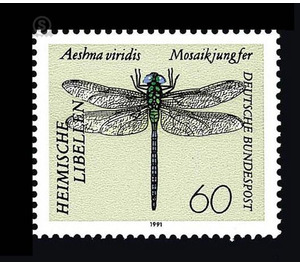Domestic dragonflies - Germany / Federal Republic of Germany 1991 - 60 Pfennig
Theme: Animals
| Country | Germany / Federal Republic of Germany |
| Issue Date | 1991 |
| Face Value | 60.00 |
| Color | brown yellow |
| Perforation | K 14 |
| Printing Type | Multi-color rotogravure |
| Stamp Type | Postage stamp |
| Item Type | Stamp |
| Chronological Issue Number | 1422 |
| Chronological Chapter | GER-BRD |
| SID | 192086 |
| In 42 Wishlists | |
The green mosaic damsel (Aeshna viridis Eversmann, 1835) is a typical representative of the noble dragonflies (family Aeshnidae). Her body length is 65 - 75 mm. It differs from other types of family u. a. by a broad black horizontal band on the forehead in front of the eyes and the monochrome green chest sides. The abdomen has species-specific mosaic-like blue spots in the male, which are dyed green in the female. The range of the green mosaic maiden extends over the northern areas of Europe and Asia. In Central Europe it is very rare and threatened with extinction. It occurs only in low moorland, lakes and ditches, where the crayfish (Stratiotes aloides) thrive, in which the females lay their eggs. The overall development takes 2-3 years. Flight time: early July to late September.


